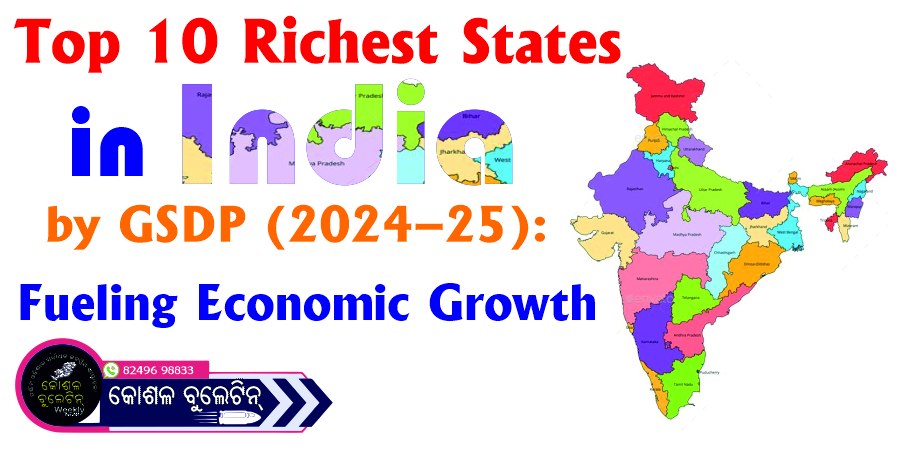India’s rapid ascent on the global economic stage is strongly driven by the combined performance of its states. As the country moves towards becoming the third-largest economy by 2030, states play a crucial role, with significant contributions to the national Gross Domestic Product (GDP). The Gross State Domestic Product (GSDP) offers a lens to evaluate the economic strength of individual states. Based on projections for the fiscal year 2024–25, here are the top 10 richest states in India by GSDP, alongside their economic highlights.
1. Maharashtra (₹42.67 lakh crore / ~$514 billion)
Leading the list, Maharashtra is India’s financial capital, driven by Mumbai’s vibrant finance, entertainment (Bollywood), and corporate sectors. Home to the BSE, NSE, and corporate giants like Reliance and Tata, it also boasts a strong manufacturing and agriculture base. Contributing ~13.3% to India’s GDP, it maintains a large, urbanized workforce, though its per capita income (₹2.78 lakh) is moderate for its size.
2. Tamil Nadu (₹31.55 lakh crore / ~$380 billion)
Nicknamed the “Detroit of Asia,” Tamil Nadu excels in automobile manufacturing, textiles, and IT services. With Chennai as a hub, the state has strong infrastructure and business-friendly policies. Its per capita income is high (₹3.50 lakh), reflecting robust industrial and service sector growth. It contributes about 8.5% to India’s GDP.
3. Karnataka (₹28.09 lakh crore / ~$338 billion)
Karnataka, with Bengaluru at its core, is India’s tech engine. Dominated by IT, biotech, and aerospace, it is home to tech giants like Infosys and Wipro. The state also has strong agriculture and manufacturing sectors. Karnataka’s per capita income stands at ₹3.31 lakh, and it contributes around 8.2% to the national GDP.
4. Gujarat (₹27.9 lakh crore / ~$336 billion)
A manufacturing and trade powerhouse, Gujarat leads in petrochemicals, pharma, and diamond polishing. Ports like Mundra and infrastructure projects have made it an industrial hub. It contributes ~8% to national GDP with a per capita income of ₹2.80 lakh.
5. Uttar Pradesh (₹24.99 lakh crore / ~$301 billion)
India’s most populous state, UP is traditionally agriculture-focused but is witnessing rapid growth in manufacturing, IT, and infrastructure. Cities like Noida and Lucknow are emerging economic centers. Despite contributing 9.2% to the GDP, its per capita income remains low (₹0.97 lakh) due to high population.
6. West Bengal (₹18.8 lakh crore / ~$226 billion)
West Bengal has a diversified economy, encompassing agriculture, manufacturing, and services. Kolkata remains a commercial hub, with a growing IT sector and port-based trade. It contributes about 5% to the national GDP with a rising per capita income of ₹1.41 lakh.
7. Rajasthan (₹17.8 lakh crore / ~$214 billion)
Known for its mineral wealth, agriculture, and tourism, Rajasthan’s economy is diversified. It contributes 5% to India’s GDP. With growing industrial zones and infrastructure development, its per capita income stands at ₹1.67 lakh.
8. Telangana (₹16.5 lakh crore / ~$198 billion)
Since its formation in 2014, Telangana has rapidly advanced, especially in IT and pharmaceuticals. Hyderabad, a global tech city, fuels growth. With a high per capita income (₹3.83 lakh), it contributes 4.9% to the national GDP.
9. Andhra Pradesh (₹15.89 lakh crore / ~$191 billion)
Andhra Pradesh thrives on agriculture, ports, and emerging sectors like IT and pharma. Cities like Visakhapatnam are growing fast. With a per capita income of ₹2.19 lakh, it contributes about 4.7% to national GDP.
10. Madhya Pradesh (₹15.22 lakh crore / ~$183 billion)
Madhya Pradesh, rich in minerals and agriculture, has a growing industrial base in chemicals, cement, and tourism. It contributes 4% to GDP with a per capita income of ₹1.49 lakh.
Together, these 10 states account for over 50% of India’s GDP. Southern states like Tamil Nadu, Karnataka, Telangana, and Andhra Pradesh are outperforming many northern counterparts in per capita income and industrial development. While regional disparities persist—evident from states like Bihar lagging in both GSDP and per capita income—India’s future growth relies on inclusive development and leveraging state-wise strengths.




